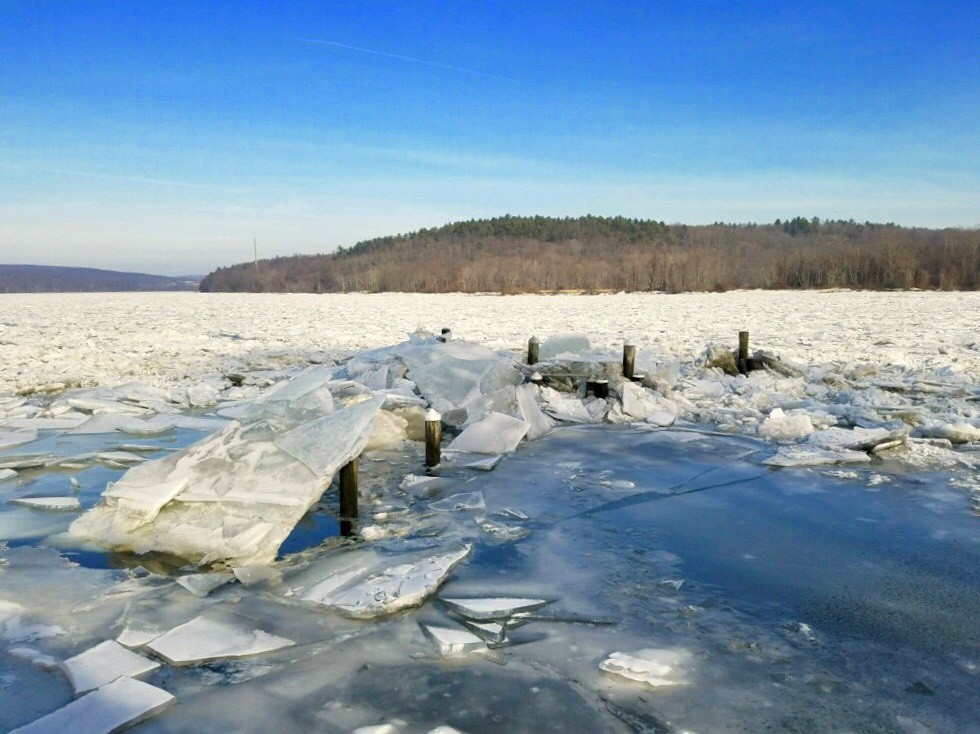
Winter 2018 Reminds Marina Operators of Risk of Ice Floes and Ice Jacking
Published on March 1, 2018Temperatures across much of the Northeast were below historical averages in early January, before warming to what was expected for the region. Then, the barometer dropped again for a time toward the end of the month. In Long Island, for instance, the first and third weeks of the month saw temperatures below average, while the rest of the month was slightly above average. To many in New Jersey, New York, Connecticut and elsewhere though, it seemed harsh. In part, that is simply because last winter was so mild. But also it is because the cold weather arrived fast, then returned, and heavy rains and winds attended the weather changes. The staccato rhythm of the weather wreaked havoc on waterways and its marinas.
After a week of abnormally cold temperatures in January, the weather improved in Connecticut. To experienced marina operators, the change in weather brought with it all the signs that ice floes might emerge along the Connecticut River. As he grew increasingly wary of the conditions, Dave Papallo, owner of Andrews Marina in Haddam, Connecticut, called the Coast Guard to ask for them to have harbor tugs come out and break-up the ice. They didn’t get there in time.
As the river began thawing with the warm up in temperatures, heavy rains added to water levels and got the ice moving. Massive pieces of ice 12 to 15 inches thick began flowing downstream. Some sections of ice were 20 to 25 feet long. At junctures where the river bends or narrows, the force of the ice sheets, which increased at bottlenecks in the river, created an ice floe 5-miles long that was a real threat to anything in its path.
“The Connecticut River had backed up,” Papallo said: “When the ice broke free, it came through like a freight train.” The ice flow began pressing against the docks at Andrews Marina at 11:53 a.m. on January 14. Over the course of the next three minutes, as shown by the surveillance camera at the marina, sheets of ice plowed over 12 piling at Andrews Marina. The ice floe also did damage to the hardware on the docks. Other marinas nearby lost piling in a similar fashion.
Ice Jacking Damage
Elsewhere, another common winter threat to marinas that struck this year was ice jacking. Ice jacking begins when water freezes around a pile. Then, as the water level changes, the pile tries dragging the ice sheet with it. Occasionally the ice breaks and chunks refreeze together. As the bond between the pile and the ice strengthens, the lift power of the bond can hoist the pile upward. It can be a fraction of an inch at first, or perhaps a few inches. Over time though, the process keeps repeating. With ice jacking, it is not unusual for a pile that appeared firmly in place at sunset to be elevated higher by several feet the following morning.
Due to the weather, ice jacking became a problem on New York’s Long Island. The Town of Brookhaven operates eight marinas along the north and south shore of Long Island. During a deep freeze in January two of the marinas in Brookhaven had piling dislodged from ice jacking: 75 piling were damaged at Forge River Marina; 30 piling were damaged at Davis Park Marina. Jack Krieger, spokesman for the Town of Brookhaven, notes that tide changes made the ice jacking possible. Though ice jacking is typically more of a problem in lake waters, tidal fluctuations mean that it can occur in sounds and other bodies of water too.

Ice jacking can occur when water freezes around a pile. As the water level changes, the ice and lifting power builds up, and it can jack up piles inches or even feet. (Photo credit: Erich Twachtman)
Prevention and Mitigation
There is not one “best” type of dock when it comes to enduring winter weather. Concrete docks and aluminum are both commonly used, as are wood, which some marina operators favor because they have a degree of flex that allows them to absorb some pressure from ice jams. Rather than the main material component “really it is more about how good the connections are between the pontoons,” said Jack Cox, a civil engineer who specializes in coastal modeling and waterfront development at SmithGroupJJR in Madison, Wisconsin.
Pontoons with thin concrete walls tend to fare poorly in ice, Cox noted, though thicker-walled pontoons are workable. Any type of material will work, “as long as you have structurally designed the pontoon appropriately,” Cox said.
Fortunately, there are a variety of measures that mitigate the risk of ice to marinas. In early winter, ice booms are commonly laid on northern rivers, like the Niagara River, as a time-tested way of breaking up ice sheets and preventing hazardous floes. Piers can be built as a series of concrete structures that function as a rake to break up ice. Various ice breaker devices can be used. All of these remedies serve as passive solutions to the threat of ice. Because of costs and scale, they are mostly geared toward communities that seek to prevent ice damage to a number of businesses on the water.
At the marina level, there are two principle active intervention methods for checking ice build-up: bubblers and eductors. Bubblers inject air into the water around docks, which breaks up ice and keeps water around piling and docks flowing. It does so because as water approaches freezing it sinks, so there is a constant reservoir of warmer water sitting near the bottom that can be used to reheat the surface. Bubblers create tiny bubbles that rise, creating a vertical current that brings the warmth back up. Bubblers are desirable because they are relatively easy and inexpensive to install; the main mechanical component is a compressor, which is housed in PVC pipe.
By comparison eductors, sometimes referred to as ice eaters, are ducted propellers that create local currents that break up ice. Beyond being good at breaking up ice, each has its particular strengths. Bubblers are generally thought to require less power and are cheaper in terms of start-up costs. Eductors, though, can be aimed, which adds to their effectiveness.
Planning Repairs
This winter may not have been unusually cold, but the rapid temperature changes, heavy rains and winds, and other weather effects combined to damage marinas, which will need repairs before the boating season. Referring to the ice floe on the Connecticut River that took out 12 piling at Andrews Marina, Papello said it was “very unusual to lose them in this manner.” Papello was methodical in preparing for the winter. All the docks at Andrews Marina were brought inside the basin, and the marina used a bubbler system to protect the piling from ice jacking. Yet, no measure could have protected the piling from the ice floe this year.
The damage amounts to an unexpected — and unwelcome — cost for Andrews Marina and other marinas throughout the region. The Town of Brookhaven expects to pay roughly $750 to $1,000 per pile to re-install the piling damaged from ice jacking. Still, all the marinas contacted for this article expect to be back in operation before long. Dave Papello at Andrews Marina has already arranged for the pile driver to come by and put them back in. Andrews Marina will be up-and-running in plenty of time for the start of the summer boating season on May 1.
| Categories | |
| Tags |





